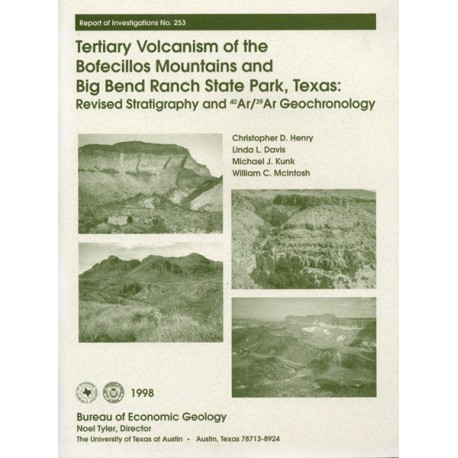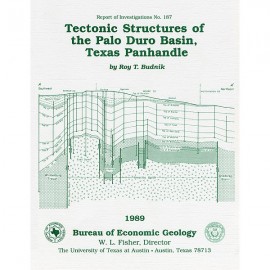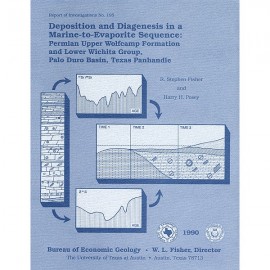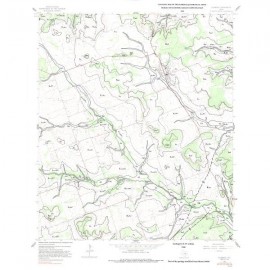Reports of Investigations
-
Books & Reports
- Reports of Investigations
- Guidebooks
- Udden Series
- Geological Circulars
- Down To Earth
- Atlases of Major Oil and Gas Reservoirs
- Texas Memorial Museum Publications
- Environmental Geologic Atlas of the Texas Coastal Zone
- Mineral Resource Circulars
- Other Reports
- Seminars and Workshops
- Handbooks
- Submerged Lands of Texas
- Symposia
- Annual Reports
- Open File Reports
-
Maps & Cross Sections
- Thematic Maps
- Miscellaneous Maps, Charts & Sections
- Geologic Atlas of Texas
- STATEMAP Project Maps
- Geologic Quadrangle Maps
- Cross Sections
- Highway Geology Map
- Energy and Mineral Resource Maps
- Shoreline Change and Other Posters
- Wilcox Group, East Texas, Geological / Hydrological Folios
- Bouguer Gravity Atlas of Texas
- River Basin Regional Studies
- Featured Maps
- Posters
- Teachers & the Public
-
Geological Society Publications
- Gulf Coast Association of Geological Societies
- Alabama Geological Society
- Austin Geological Society
- Corpus Christi Geological Society
- Houston Geological Society
- Lafayette Geological Society
- Mississippi Geological Society
- New Orleans Geological Society
- South Texas Geological Society
- GCS SEPM Publications
- Historic BEG & UT Series
Tertiary Volcanism of the Bofecillos Mountains and Big Bend Ranch State Park, Texas:
RI0253
Tertiary Volcanism of the Bofecillos Mountains and Big Bend Ranch State Park, Texas: Revised Stratigraphy and 40Ar/39Ar Geochronology, by C. D. Henry, L. L. Davis, M. J. Kunk, and W. C. McIntosh. 74 p., 24 figs., 3 tables, 2 appendices, 1 map, 1998. Print Version.
For a downloadable, digital version: RI0253D.
The Bofecillos Mountains and Big Bend Ranch State Park contain a complex sequence of volcanic, volcaniclastic, and intrusive rocks that erupted from sources both within and outside the area. Detailed geologic mapping and stratigraphic, petrographic, geochemical, and 40Ar/39Ar and K-Ar studies justify substantial revision of previously recognized relationships. Magmatism occurred in several distinct episodes between 47 and 18 Ma ago, spanning the complete range of activity in Trans-Pecos Texas. Major groups of rocks erupted at approximately 32 to 31 Ma, 29 Ma, 28 to 27 Ma, and 25 to 18 Ma from sources within the Bofecillos Mountains.
Older volcanic rocks in the Bofecillos Mountains and state park erupted from sources mostly outside the area. The Chisos Group of lavas, tuffs, and tuffaceous sediments crops out in the southeast and south parts of the state park. Volcanic rocks erupted from sources to the south and east in two distinct pulses at 47 and 34 to 33 Ma. The first pulse consisted solely of the 47-Ma-old Alamo Creek Basalt, one of the oldest volcanic rocks of Trans-Pecos Texas. The second pulse consisted of the Bee Mountain Basalt, the Tule Mountain Trachyandesite, and the Mule Ear Spring Tuff. Volcanic rocks in the northwest panhandle of the state park erupted from several local sources, as well as from sources in and around the Chinati Mountains caldera to the northwest. These include the 37?- to 32-Ma-old Morita Ranch Formation, which consists of rhyolite and basalt lava; the 32.8-Ma-old Mitchell Mesa Rhyolite; and the 32.7-Ma-old Cienega Mountains Rhyolite, a peralkaline rhyolite lava dome. The Mitchell Mesa Rhyolite, the most voluminous and widespread ash-flow tuff of Trans-Pecos Texas, erupted from the Chinati Mountains caldera and spread throughout what is now the state park. The Solitario laccolith-caldera system, immediately east of the Bofecillos Mountains, formed by (1) a complex sequence of early sill, laccolith, and dike injection; (2) doming during intrusion of the main laccolith; (3) ash-flow eruption; (4) caldera collapse; (5) intracaldera volcanism and sedimentation; and (6) late intrusion. These events occurred in three distinct stages at 36.0,35.4, and 35.0 Ma.
This report greatly revises the Fresno and Rawls Formations, which consist of lavas and tuffs that erupted from a series of volcanoes within the Bofecillos Mountains and which blanket the area. The Fresno Formation is composed of two major parts: quartz-normative trachyte that erupted 32 to 31 Ma ago (Rancherias Lavas Member) and nepheline-normative basalt that erupted about 29 Ma ago (Campo Javelina Basalt Member). The Rawls Formation is redivided into six members. The Las Burras Lavas Member consists of aphyric and porphyritic basalt emplaced between 27.8 and 27.3 Ma. The Leyva Canyon Lavas Member consists of quartz trachyte to rhyolite lavas and minor tuffs that erupted in two pulses at 27.3 and 27.1 Ma. The Sauceda Lavas Member consists of nepheline-normative basalt to trachyte lavas. The Segundo Lavas Member consists of a heterogeneous mix of quartz trachyte lavas and related ash-flow tuffs, nepheline-normative trachyte, and conglomerate. The Rancho Viejo Tuff Member is a nepheline-normative trachyte ash-flow tuff. The Alazan Lavas Member consists of basaltic to trachytic lavas nearly identical to the Sauceda lavas. The four younger members have indistinguishable 40Ar/39Ar ages of about 27.1 Ma, a time of voluminous and diverse magmatism in the Bofecillos Mountains. Two major ash-flow tuffs, the 30.5-Ma-old San Carlos Tuff and the 27.8-Ma-old Santana Tuff, erupted from the Sierra Rica caldera complex in Chihuahua and flowed into the Bofecillos Mountains, where they are interbedded with the Fresno and Rawls Formations.
The Closed Canyon Formation, formerly member 9 of the Rawls Formation, consists of nepheline-normative basalt, coarse sedimentary rocks, and rare rhyolite ash-flow tuff that were emplaced contemporaneously with initial basin-and-range faulting in the region. The volcanic rocks erupted from widely scattered vents throughout the Bofecillos Mountains between 25 and 18 Ma ago, which is indicative of some of the youngest volcanism in Trans-Pecos Texas.
Major- and trace-element geochemical data of basalts indicate a change from lithospheric-dominated sources before about 30 Ma to asthenospheric-dominated sources afterward. This change is consistent with interpretations of structural and tectonic data indicating that pre-30-Ma magmatism was part of a continental volcanic arc related to subduction off the west coast of North America and that post-30-Ma magmatism is related to regional, basin-and-range extension.
CONTENTS
Abstract
Introduction
Regional Setting
Geochemical, 1sotopic-Age, and Paleomagnetic Data
K-Ar and 40Ar/39Ar Dating
40Ar/39Ar and K-Ar Data and General Interpretation
Paleomagnetic Data
Prevolcanic Rocks
Chisos Group: Contrabando Lowland and Southern Bofecillos Mountains
Bofecillos Mountains
Alamo Creek Basalt (Tcac)
Sedimentary Strata of the Undifferentiated Chisos Group (Tc)
Bee Mountain Basalt (Tcbm)
Mule Ear Spring Tuff (Tcm)
Tule Mountain Trachyandesite (Tctm)
Influence of the Terlingua Uplift on Distribution of the Chisos Group
Devils Graveyard Formation (Tdg)
The Solitario
Introduction
Predome Sills
Central Intrusions
Needle Peak Rhyolite (Tir3)
Doming and Contemporaneous Intrusions
Ash-Flow Eruption and Caldera Collapse
Filling of the Caldera
Late Intrusions
Erosion of the Solitario
Terneros Creek Rhyolite (Tpr)
Cienega Mountains Area: Volcanism Related to the Chinati Mountains
Morita Ranch Formation (Tm)
Mitchell Mesa Rhyolite (Tmm)
Cienega Mountains Rhyolite (Tcr)
Tascotal Formation (Tta)
Perdiz Conglomerate (Tp)
Volcanism of the Bofecillos Mountains
Fresno Formation (Tf)
Rhyolite Lava Dome (Tfr)
Rancherias Lavas Member (Tft and Tftp) and the Fresno Volcano
Peralkaline Rhyolite Lava Dome (Tfpr)
Campo Javelina Basalt Member (Tfb)
Tuffaceous Sediments of the Fresno Formation (Tfs)
Sierra Rica Caldera Complex
San Carlos Tuff (Tsc)
Santana Tuff (Ts)
Rawls Formation and the Bofecillos Volcano
Las Burras Lavas Member (Trb; formerly member 1)
Leyva Canyon Member (Trl; formerly members 2 and 3)
Lavas (Trlr, Triq1, Trlq2, and Triq3)
Ash-Flow Tuffs (Trla1 and Trla2)
Sedimentary Deposits (Trid and Trlc) 34
Sauceda Lavas Member (Trs; formerly members 4 and 5)
Erosion Following Sauceda Lavas
Segundo Lavas Member (Trg; formerly parts of member 7)
Rancho Viejo Tuff Member (Trr; formerly member 7at)
Alazan Lavas Member (Tra; formerly member 8)
The Bofecillos Vent
Intrusions
The "Bofecillos Volcano"
Closed Canyon Formation (Tm; formerly member 9)
History and Geometry of Faulting
Sedimentary Rocks (Tmg, Tmsg, and Tmsc)
Basalt (Tmb)
Ash-Flow Tuff (Tma)
Geochemistry of Magmatism of the Bofecillos Mountains
Pre-31-Ma Rocks
Bee Mountain Basalt
Rancherias Lavas Member of the Fresno Formation
Post-31-Ma Rocks
Campo Javelina Basalt Member of the Fresno Formation
Las Burras Lavas Member of the Rawls Formation
Sauceda and Alazan Lavas Members of the Rawls Formation
Silicic Rocks of the Rawls Formation
Closed Canyon Formation
General Characteristics of Post-31-Ma Basalts
Tectonic Implications
Acknowledgments
References
Appendices
1. Chemical analyses of igneous rocks. Big Bend Ranch State Park
2. Petrography of igneous rocks. Big Bend Ranch State Park
Figures
1. Location map of Big Bend Ranch State Park
2. Map showing calderas and other volcanic centers of southern Trans-Pecos Texas and adjacent Chihuahua, Mexico
3. Satellite image of Big Bend Ranch State Park and adjacent areas
4. Diagrammatic stratigraphy of Tertiary rocks around the Solitario
5. Diagrammatic stratigraphy of Fresno and Rawls Formations in the Bofecillos Mountains
6. Histogram of 40Ar/39Ar and K-Ar ages determined on volcanic rocks of the Bofecillos Mountains area
7. Age spectra
8. Stereonet plot of paleomagnetic directions of volcanic rocks of the Bofecillos Mountains area
9. Photograph of the Chisos Group in the west face of South Lajitas Mesa
10. Oblique aerial photograph of the Solitario, looking northeast across the dome
11. Cross sections showing stages in evolution of the Solitario laccolith and caldera
12. Graphs showing total alkalis versus SiO2 in volcanic rocks of the Bofecillos Mountains
13. Photograph of south face of Santana Mesa, viewed from FM 170 west of Big Hill
14. Photograph, looking southwest toward thick Leyva Canyon lavas
15. Photograph, looking west toward rocks of the Rawls Formation near Cuevas Amarillas
16. Photograph, looking east over the high plateau that makes up the eastern Bofecillos Mountains
17. Photograph, looking north toward Three-Dike Hill along FM 170 in the southwest part of the state park
18. Vertical aerial photograph of the Bofecillos vent
19. Generalized map of basin-and-range faults, contemporaneous basalts of the Closed Canyon
Formation, and basin-fill deposits of southern Trans-Pecos Texas and adjacent Chihuahua, Mexico
20. Photograph of surface of west-northwest-striking basin-and-range fault along FM 170 approximately 4 km west of Lajitas
21. Graph showing saturation index versus MgO in volcanic rocks that have sources in the Bofecillos Mountains, including Bee Mountain Basalt and Fresno, Rawls, and Closed Canyon Formations
22. Element-normalization diagram of volcanic rocks of the Bofecillos Mountains
23. Element-normalization diagram normalized to mean OIB composition
24. Plot of Zr/Nb ratios versus age of volcanic rocks, Bee Mountain Basalt and Fresno, Rawls, and Closed Canyon Formations
Tables
1. Revised volcanic stratigraphy of the Bofecillos Mountains and Big Bend Ranch State Park
2. 40Ar/39Ar and K-Ar data, Big Bend Ranch State Park
3. Paleomagnetic data, Big Bend Ranch State Park
Map (two plates)
Geologic map of Big Bend Ranch State Park, scale 1:50,000
Citation
Henry, C. D., Davis, L. L., Kunk, M. J., and McIntosh, W. C., 1998, Tertiary Volcanism of the Bofecillos Mountains and Big Bend Ranch State Park, Texas: Revised Stratigraphy and 40Ar/39Ar Geochronology: The University of Texas at Austin, Bureau of Economic Geology, Report of Investigations No. 253, 74 p.






